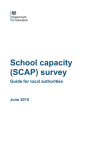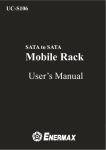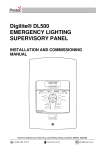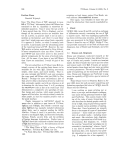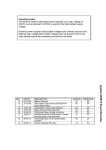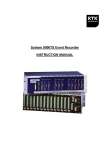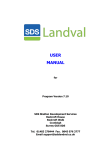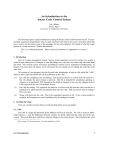Download School capacity survey 2015: guide for local authorities
Transcript
School capacity (SCAP) survey Guide for local authorities June 2015 Contents Summary 3 Part 1 School Capacity Return 4 1.1. Schools covered by the capacity strand 4 1.2. Pupil numbers on roll (NOR) 5 1.3. School Capacity 5 1.4. Pupils in excess of capacity 6 1.5. Published Admission Numbers (PAN) 7 1.6. Number of year groups 7 PART 2 - LA Pupil Forecasts 9 2.1. Pupil Forecasts 9 2.2. S106/CIL forecasts 9 2.3. Forecast methodology 10 PART 3 - Commentary 11 PART 4 - Capital Spend Data 12 4.1. Introduction 12 4.2. Capital Spend and Additional Places 13 4.3. Future Capacity 15 PART 5 – Accessing the systems and submitting your returns 17 Appendix A – Net Capacity Guidance 19 Appendix B – Example Scenarios for capacity and forecast 21 Appendix C – Forecast Validation Rules 24 Appendix D - Capital Spend Data 26 2 Summary About this departmental advice This is departmental advice from the Department for Education. This advice has been produced to help local authorities understand the data required in relation to the School capacity survey as defined in The Information as to Provision of Education (England) (Amendment) Regulations 2013. Review date This advice will next be reviewed for June 2016. Main points This guidance will provide you with the information you need to complete the SCAP survey. The survey is split into 3 parts: a. Capacity; b. Forecasts; c. Capital Spend; i. Capital spend and additional places; ii. Future capacity. There have been no changes to the data fields that are collected in SCAP 2015 in comparison to SCAP 2014, with one exception. For SCAP 2015, you are only required to complete the capacity in use field on the capacity strand where school has expanded since September 2014 rather than September 2010 (see part 1.3.1 for details). Forecast and capacity data will continue to be collected via the COLLECT system. Capital spend data will be collected via a new online portal rather than the spreadsheets used in SCAP 2014. This will allow LAs to validate their data before it is submitted. The capital spend data fields are the same as last year. This guidance document should be read in conjunction with: • the COLLECT Data Collection User Manual • the Capital Spend Online Data Collection User Manual These technical guides will help you to navigate the data collection systems. 3 Part 1 - School Capacity Return The school level data within the school capacity return should reflect the position as at 1 May 2015. The school capacity and forecasting elements of the on-line collection include planning area reference codes and school establishment codes that have been taken from the lists that you provided prior to the survey going live. 1.1. Schools covered by the capacity strand Survey returns must include all schools which were maintained by the local authority at 1st May 2015, and open Academies, Free Schools, CTCs, UTCs and Studio Schools in the local authority area. Survey returns must exclude special schools (including special free schools, academies that are special schools or alternative provision), nursery schools, nursery units within schools, pupil referral units (including any free school or academy that is a pupil referral unit), independent schools and 16-19 establishments. You will need to check the school list on COLLECT and make changes where a school is showing incorrectly, for example due to closure, academy conversion or amalgamation, so that the list accurately reflects schools as at 1 May 2015. • • • If a school has closed and features on the COLLECT system, please mark it as being closed in the appropriate field on COLLECT. For any new schools (not by conversion or amalgamation) that do not feature on COLLECT, please add these schools in the section ‘new schools’. You are required to complete all other data fields for the school, including the number on roll. For any schools that have converted or amalgamated since the school list was completed, please mark the current schools as closed and click the “Close existing school and preserve data to create a new school (overnight)” button. For anamalgamation you should only do this for one school. This will close the maintained schools and create a ‘new school’ where all prepopulated data will be transferred to a ‘new school’ record. You will need to update the school name, establishment number, capacity figures, governance code and published admission numbers to reflect changes after conversion or amalgamation. We have communicated with Academies via the EFA regular bulletin about SCAP 2015 so they are aware that they need to assist local authorities and provide up-to-date information if requested. 1.2. Pupil numbers on roll (NOR) The actual NOR for each school will be pre-populated from the number of registered pupils on the January Schools Census. The pupil count includes sole registration and dual main registration status. Part-time pupils are included on a head-count basis. All fulltime and part-time pupils in a designated nursery class are excluded. The output reports which are available to you from the school capacity blade on COLLECT include a breakdown of numbers on roll by year group. This data has been taken from the January Schools Census. If you are entering details in the `new schools’ section, you will need to provide the NOR for each year group for that school including any Year 14 pupils. Clarification: The May census data will be uploaded to COLLECT so it can be integrated into our final SCAP dataset and be used in the calculations for the published capacity and forecast tables. For this SCAP collection, no data will be validated against the May census data. This decision was taken in order to reduce confusion around changing validation results during the course of the collection, and to remove the burden on local authorities having to recheck data once the May upload had taken place. 1.3. School Capacity The capacity information for all schools open at 1 May 2014 has been pre-populated using the capacity figures from SCAP 2014. For free schools that opened in September 2014, the capacity information has been prepopulated from their funding agreements and reflects the final capacity of the school. For all academy conversions and amalgamations open after 1 May 2014 where we have been able to link the convertor or amalgamation to the previous maintained school, we have prepopulated the capacity data from SCAP 2014. We ask that you amend net capacity details for maintained schools where they have changed since May 2014 and confirm capacity details with your academies, updating on COLLECT where necessary. You should hold up-to-date net capacity assessments for all LA maintained, VA, VC and foundation schools, as the assessments are a statutory requirement for the School Capacity Collection. For more information on calculating net capacity, please see annex A. For all schools please complete the total capacity field. Where the type of school is middle-deemed primary, middle-deemed secondary or all-through, you must also complete both the primary and secondary capacity fields. The combined figures must equal the total capacity of the school. 5 If you have entered zero as a value in a capacity field this will create an error and you will not be able to submit the return. All open schools should have a value in the capacity field. 1.3.1. Capacity in Use field You need to complete this field if you have any schools that have opened or expanded since September 2014 by at least 30 places (1FE) in each year group, and are filling up year on year. The ‘capacity in use’ figure should reflect the number of places that are currently operating and in use rather than available to use as indicated in the net capacity assessment or final funding agreement (equal to total capacity field). For example, consider a 1FE primary school has expanded to 2FE, but in September 2014 only offered 60 places in Reception rather than in every year group. The ‘capacity in use’ figure should be 240 to reflect the 210 places already available plus the extra 30 places that are available in reception. Clarification: You are not required to enter the capacity in use field for any school where expansion occurred before September 2014. We can refer to the SCAP 2014 data if we need to revisit the earlier expanders. We are not asking you to resubmit information about the capacity in use in those schools in order to limit the amount of information that we are seeking. We realise that in requesting capacity in use data only for those schools which have expanded since September 2014, that we will not have a full list of capacity in use for all schools which are currently filling up. You will also be asked to provide the funding source that was used to provide these places by selecting one of the options from the drop down menu. This field should reflect the funding you have indicated in your capital spend data. We are collecting this information as we know that some LAs strategically plan the creation of school places in areas where there is a shortfall and add new places in whole forms of entry, well in advance of need. We would like to understand how many LAs are doing this and how they are funding these places. 1.4. Pupils in excess of capacity We ask that you explain why there are a high number of pupils in excess of capacity in the notes section. We will not accept a return if explanatory notes have not been provided for all schools where a query has been raised. 6 The query is raised where a primary school has 20 or more pupils in excess of capacity or a secondary school has 100 or more pupils in excess of capacity. You will need to provide this information even if you provided it to us in SCAP 2014. This year the validation will not be rerun using the May census data so you are only required to address the queries raised from the January census data. 1.5. Published Admission Numbers (PAN) The PAN data provided in SCAP may not reflect the PAN the local authority used as part of the pupil admission process. For SCAP the PAN figure should relate to the number of pupils admitted when that years cohort joined the school. If an intake year is higher than that originally published, for instance the school has taken a bulge year, then the PAN should reflect the higher intake admission number. If additional pupils have been admitted through appeals, we do not require you to reflect this in the reported PAN. PAN data will be pre-populated from SCAP 2014, rolled forward a year. For example a PAN for ‘R’ cohort in 2014 will be pre-populated for Yr1 for SCAP 2015. You will only need to enter the PAN for the missing year/years of entry to the school. LAs should hold PANs for all schools, including Academies, as co-ordinators of admissions for schools and pupils resident in their area. For new or expanded schools filling up year on year, we need the final intended PAN for each national curriculum year group within the school, not just for those year groups that are currently operating. See Annex B for further information about correctly representing your PAN data. We do not collect PANs for years 12 and 13 but these year groups are included in the NOR and need to be reflected in the total capacity of the school. Where there is a difference between the total PANs and capacity of a school of ± 30 at primary or ±100 at secondary, a query message will be generated and you will need to provide an explanation. We will not accept your return, if explanatory notes have not been included for all schools where a query has been raised. 1.6. Number of year groups We have pre-populated the number of national curriculum year groups for each school from SCAP 14. Please check that the number of year groups for each school is correct and amend if necessary. 7 A year group is deemed to have 1 or more pupils in attendance. If the number of year groups has changed (due, for example, to a change in age-range or addition of a sixth form) then you will need to amend this field. Where a school has Year 14 pupils on roll, you do not need to reflect this in the number of year groups. For example a maintained secondary school with 6th form provision would show as 7 year groups. If the number of year groups provided is not equal to the number of PANs provided you will need to provide an explanation in the notes section. Where this is due to the existence of 6th form provision and a result of not collecting PANs for years 12 and 13, then please just note ‘sixth form’ in the notes section. 8 Part 2 - LA Pupil Forecasts 2.1. Pupil Forecasts Pupil forecasts include pupils expected to attend mainstream community, VA, VC and foundation primary and secondary schools, Academies, Free Schools, CTCs, UTCs and Studio Schools. Exclude places funded by s106/CIL agreements (see point 2.2). You must enter the correct forecast figures relevant to the appropriate year groups for both primary and secondary phases within your relevant planning areas. We expect your forecast to take account of the number of places needed across the whole year, however COLLECT requires you provide a time of year that the forecasts were calculated – January, April or September. You will only need to enter this in one primary planning area and one secondary planning (but for both years 7 to 11 and years 12 to 13) and this will then cascade to all other planning areas. Where you have sixth form provision in secondary schools you will need to ensure that you have entered forecast data for years 12 and 13. If you anticipate any year 14 pupils these should be included in your year 13 forecasts. Your forecasts should reflect the pupils that you expect to have to provide places for in each relevant academic year. Do not include a margin in your forecasts to reflect spare places that you need to manage in-year admissions, mobility or parental choice. You can and should, though, include in your forecasts your well-grounded expectations about pupils arriving during the year – not just those coming through the main application process. Most authorities do this based on their past experience of in-year arrivals. Additionally your pupil forecasts should only include expected pupil yields from housing developments that have full planning permission or where the LA can demonstrate a degree of certainty that the development will go ahead within the timeframe of the forecasts. Where a school is split between different planning areas because it operates from different sites, you will need to take this into account when producing your pupil forecasts. To ensure that school capacity can be divided to reflect this split, local authorities should have advised of the relevant different planning areas for split site schools. For clarity, it would also be helpful if you could also include a note against these schools on your capacity return advising of the capacity within each planning area. 2.2. S106/CIL forecasts S106/CIL pupil forecasts provide the expected number of pupils that will be attending primary and secondary school in places that will be created using s106/CIL developer 9 funding from 2015/16 onwards. These pupil forecasts should be completed in the same way for each year group but at LA wide level as opposed to planning area level. Pupils in s106/CIL funded places must be excluded from the main planning area forecasts to avoid potential double funding. Pupils in s106/CIL funded places should be included in the separate s106/CIL forecast section (which has been included on the XML template this year). Where s106/CIL funding is used to supplement an existing project, the number of pupils in s106/CIL funded places should relate only to the proportion of places generated through s106/CIL funding. This information will be cross referenced against your capital spend data. The reporting of pupils in s106/CIL funded places is cumulative. Where S106/CIL funded places have been included in one forecast year, they should appear in future forecast years, along with any additional places added in those future years. All s106/CIL pupil forecasts need to be taken out of all future years in the main planning area forecast, not just the year they became available for pupils to attend. Therefore when your main PA forecasts and s106/CIL forecast are added together it should represent the total amount of pupils you are expecting to provide places for. 2.3. Forecast methodology The methodology statement is intended to set the figures in context. This is important since projection methodology varies from one local authority to another. Please provide comprehensive information. Please do not include information on your forecasting methodology in the ‘Commentary’ that sets out local place planning issues. The forecast methodology can be returned via COLLECT or as a Word document to [email protected]. 10 Part 3 - Commentary Local Authorities must complete a ‘Commentary’ template. This provides information that will assist in analysis of pupil place planning pressures. It offers an opportunity to qualify the impression that might be obtained from your data return. The commentary must link to your planning area information, identifying any local pockets where school capacity is an issue. Please use the commentary to explain where there is planned action to secure additional capacity, indicating whether this is temporary or permanent and in new schools or expansions. Please also use the commentary to provide an explanation of any other significant changes to capacity, such as school closures, when they would be implemented and how this would affect the places available. In summary, the commentary should include details of any plans that would significantly impact on available capacity. Please provide contextual information rather than brief comments alongside particular schools as the Department uses any such observations to understand the overall effect on the figures for the LA as a whole. 11 Part 4 - Capital Spend Data 4.1. Introduction The Capital Spend Data (CSD) collection helps the Department to understand how additional school places are being provided and funded. The Capital Spend Return should include: • All projects that have been or will be delivered using basic need funding, where those projects deliver places from the 2010/11 academic year onwards. Including: o Mainstream and non-mainstream projects (projects providing special, nursery or post-16 places); o Schemes that improve facilities but do not add places. • All projects that provide additional school places, even if: o The LA has used other sources of funding to provide those places; o The additional places are provided at zero cost. As a general rule, you should not include projects which are centrally funded where you are adding no further funding. If you are not providing supplementary funding or places, please exclude all the following types of projects: • • • • Priority School Building Programme (PSBP); Free School Programme (includes Free Schools, UTCs and Studio Schools); Academies Capital Maintenance Fund (ACMF); School Condition Improvement Fund (CIF); Clarification – addition to list of excluded projects: • Building Schools for the Future (BSF). If you are providing supplementary funding or places, then you should provide details of that supplementary funding. In those cases, only record funding you are contributing to the projects and the additional places related to that funding, not the central capital. Please give full details for Targeted Basic Need projects, including both the centrally funded element and any supplement. We are aware from CSD 2014 that there is significant supplementary activity and wish to continue to record that. For the first time, the 2015 capital spend data will be collected via an online portal. Data is collected via two strands: capital spend and additional places (previously called places provided and pipeline), and future capacity. 12 4.2. Capital Spend and Additional Places The capital spend and addition places strand should be completed for projects that use basic need funding allocations and/or create additional mainstream places from the 2010/11 academic year onwards, where funding is committed. We would normally expect this to be where the local decision maker (e.g. mayor or cabinet) has signed off the capital plans or where contracts have been let. You should list all additional places being provided, any existing places being re-provided and any additional places or existing places being re-provided that are in the delivery pipeline. The online portal will be pre-populated with the data submitted by each local authority in their 2014 CSD return. Therefore you will not need to re-submit previous data unless you need to make changes, for example if some information has changed or the original submission contained errors. Please check through previously submitted data to make sure that it is still correct, paying particular attention to any projects where you had previously not split out the funding between additional and reprovided places, or between mainstream and SEN places, and where you are now able to provide that information. Local authorities will have the option to complete each strand within the online portal, or to download an excel spreadsheet, enter information onto it, and then upload the spreadsheet back into the online portal. The downloaded spreadsheet will not contain the pre-populated 2014 data, which would need to be copied or re-entered. LAs should be aware that uploading an excel spreadsheet into the system will over write any existing data in the system including the pre-populated data from the 2014 CSD return. Any errors in this data must be corrected online and any new data entered online. LAs should therefore give careful thought to how they wish to complete the capital spend and additional places strand before starting their return. We would suggest: Either • Any errors in data submitted in CSD 2014 are corrected in the online portal and new data is added in the online portal. This is more suitable if you have small numbers of additional projects. • The spreadsheet is downloaded, data submitted in CSD 2014 is copied into the spreadsheet from last year’s return (which can also be downloaded from the online portal using the report function) and new data is added to the spreadsheet before it is uploaded back into the system. The system will then flag up any errors which must be corrected online in order to submit your capital spend return. This is more suitable if you have large numbers of additional projects. Or Technical details of how to use the system to edit and add projects are given in the Capital Spend Online Data Collection User Manual document. 13 4.2.1. General Guidance Use of basic need funding: If basic need funding has been used to provide SEN, nursery, year 12 and year 13 places, then these should be recorded as appropriate. Projects which used basic need funding but did not create any additional places e.g. maintenance/enhancement projects should also be recorded. If basic need funding has been used on a non-specific project, i.e. has been spent on improving several schools in the area and it is not possible to break this down to individual project level, you should enter this information in the free text box on your LA’s capital spend and additional places landing page which allows you to explain how you have spent the remainder of your basic need funding. Projects which created mainstream additional places but had zero cost attached should be recorded, as should projects which created mainstream additional places but used no basic need allocations and instead were funded from other sources. Table D1 in the appendix provides further information for specific treatment of centrally funded programmes. Mixed projects – provision of additional and existing places: Where a project re-provided existing places plus created some additional places, ‘Mixed - Creates both additional places and rebuilds existing places’ should be chosen as the type of project. Further detail is given the Project Type section below in the appendix. Mixed projects – provision of mainstream and SEN places: Similar to above, Mixed Creates both additional places and rebuilds existing places’ should be chosen as the type of project. As in the 2014 collection, you should record the number of mainstream and SEN places separately. Further detail is given the Project Type section below in the appendix. Permanent places replacing temporary places: Select this type of project from the drop down list where basic need allocations have been used to provide permanent places in a school where temporary places are currently in operation. This could mean funding spent on a permanent building where a series of bulge classes (in temporary accommodation) have been replaced. Please note, the number of places should be recorded as reprovided. However, if a project is replacing temporary places and creating new additional places, type of project ‘Mixed – Creates both additional places and rebuilds existing places’ should be used, and additional and re-provided places recorded separately. Multi phased projects: If the number of places provided by a project are built together, but they fill up over a number of years (e.g. a phased intake) then please fill in the value of the whole project and record it against the academic year that the places were built. If a temporary solution is put in place until a permanent extension is built, please record the whole project on one line and record it against the academic year that the temporary solution was put in place. However, if there is a time lag in a project (e.g. KS1 is remodelled first with KS2 to follow) the number of places and the project costs should be 14 apportioned as well as possible and recorded on two separate lines, against the appropriate academic years. Infant and junior Schools: If a project applies to both an infant and junior school please estimate the split between the two schools, ensuring that the grand total is correct. If it is not possible to do this then the project may be submitted on one line. One ESTAB number will need to be added which the project will be recorded against. Additional information and the ESTAB number of the other school can be given in the additional information section All through schools: If a project applies to an all through school data should be entered in the same way as that for all other schools, with the start year group and end year group selected as appropriate, even where this crosses the primary/secondary divide. The ESTAB number links schools to the appropriate school type and planning area(s) which are used during the analysis phase. Section D.1. in the appendix is provided to show how the capital spend return may be completed for different scenarios and project types. 4.2.2. Data Fields The Data Field section in the appendix provides further details on each data field within the capital spend data collection 4.3. Future Capacity 4.3.1. Introduction The future capacity strand should be completed for places planned to be added by the local authority in 2015/16, 2016/17 and 2017/18 for each planning area and for each year group where funding is committed. When completing the future capacity strand please also refer to the guidance in section 4.1 Capital Spend Introduction for specific treatment of centrally funded programmes. 4.3.2. General Guidance Bulge classes should be recorded as 30 places in the start year only (e.g. reception) while a 1FE expansion should be recorded as 30 places per year group reception to year 6. Please include all additional capacity as built, not just the number of places that would be used in a given year, e.g. if a 1FE expansion is planned for 2015/16, but only 30 places used in that year, 30 places should still be entered for each year group (210 in total) as the full capacity is available in that year. 15 Increases in capacity due to increases in PANs (e.g. through re-commissioning space) should be shown on the future strand as number of places by year group in the relevant planning area by the each of the forecast years they come into use. The total figures on the future capacity strand should tally with the total figures for mainstream places added on the capital spend and additional places strand (by year places become available). For example, if a project added 210 places in 2016/17 across Reception to year 6 on the capital spend and additional places strand, these should be reflected in the correct planning area on the future capacity strand, with 30 places recorded for each year group in 2016/17. There may be some exceptions to this if basic need funding has been used to fund additional nursery, year 12 and year 13 places as they will be recorded on the capital spend and additional places strand but not on the future capacity strand as the latter only records additional places in year groups R to 11. 4.3.3. Data Fields Planning area reference code and planning area name: These will be prepopulated using the information provided on SCAP 2015 school list. No action is needed. Places to be added - individual year groups: Please enter the number of places planned to be added by the local authority in 2015/16, 2016/17 and 2017/18 for each planning area and for each year group where funding is secure. These cells will be pre-populated with a zero. If no places are planned in that year, year group or planning area, please leave the zero in the cell. If the zero is removed and a cell is left blank, it will generate an error. Please enter whole numbers only. If you do not know the exact breakdown by year group please estimate as best you can. Total places to be added: This is a calculated column and sums up the total primary (R to 6) or secondary (7 to 11) places planned to be added in each year and planning area. No action is needed. 16 Part 5 – Accessing the systems and submitting your returns 5.1. Accessing the data collection systems • Capacity and forecast data collection. If you have issues accessing COLLECT, please contact the Data Collection Helpdesk using the service request form. • Capital spend data collection system. Login details will be emailed to the capital spend contacts in each local authority. If you have not received login details by the time the survey goes live please email [email protected]. 5.2. Using the QA checklist and output reports You have been provided with a QA checklist. This list provides a guide on checking your data prior to submission. It is not an exhaustive list and should be undertaken in addition to rigorous checking of the data as it is entered. Accurate data entry and completion of this list will prevent or reduce the number of questions that we may subsequently need to ask you. We do not require you to return the completed checklist to us, but please ensure that all checks have been carried out prior to data submission. COLLECT features a primary and secondary capacity report along with a notes report. The COLLECT system refreshes overnight, so any data that you input will not show on the output reports until the following day. The CSD portal also features an output report in which you can see all your submitted data. You are advised to use these output reports in conjunction with the QA Checklist. This will help you address any issues with your data prior to submission. 5.3. DCS sign-off You will need to arrange for your own internal review of your data and for your DCS to sign off the data as true and accurate. A template is provided for this. 5.4. Submitting your return You will be unable to submit your returns if you have not addressed all error messages. If you are unable to resolve any errors, please send an urgent e-mail to the Pupil Place Planning Team’s e-mail address [email protected]. 17 All data must be submitted using the online systems. Email copies of the downloaded spreadsheets or output reports will not be accepted. Accompanying information should be e-mailed to the Pupil Place Planning Team at [email protected] and should include: a. The commentary b. The forecast methodology (if not submitted via the system) c. The DCS sign off form. Your return will only be valid when you have provided all elements. 18 Appendix A – Net Capacity Guidance The net capacity of a school is based on the net area of all buildings that are available to that school and should include all extra places that have been added to the school (even though they may not yet be in use), any classrooms that have been mothballed or nonteaching space that has been re-designated as a classroom. These comprise: • all buildings including temporary accommodation, on any site used by the school, that are owned or maintained by the Local Authority, Governing Body or Trustees and are intended to be secure and weather-tight; • `non-maintained’ accommodation used by the school. The net area of any `nonmaintained’ accommodation should also be measured and included if it is available for the school to use during at least 80% of any normal school week. When completing the net capacity assessment form for a school which has taken a bulge year (or two), the LA should add the number of years and the extra group size in boxes c and d on the net capacity form, as shown below, to increase the capacity without changing the indicated admission number at box z. In primary schools, this will also rely on the extra classroom being marked with a ‘C’ in the status column of the schedule of rooms. Where the number on roll has increased because more pupils are being taught in classrooms under 49m2 (the minimum size for 30 pupils), the capacity need not be changed unless further areas are also being used for some classes, in which case these should be marked with a ‘C’ in the status column of the schedule of rooms. The same method applies where a school has reduced its published admission number for the lower year groups but the higher PANs still exist in the higher year groups – the net capacity assessment should include both the higher and lower PANs. 19 Where an infant or primary school operates a foundation unit that includes Reception pupils, you need to ensure that the net capacity figure submitted includes any teaching space used by this year group. We expect the number of places available as shown in the survey return to include all available capacity from Reception to Year 6 at primary level. Further information on calculating the net capacity assessment of maintained schools can be found in the guidance document Assessing the Net Capacity of Schools. 20 Appendix B – Example Scenarios for capacity and forecast Listed below are different scenarios and how they should be represented in your return. B.1. Capacity examples B.1.1. A 1FE school has taken a bulge year in 2013/14 but is not expanding Capacity 240 Capacity in Use PAN R PAN 1 N/A 30 60 PAN 2 PAN 3 PAN 4 PAN 5 PAN 6 30 30 30 30 30 The capacity field is from the net capacity assessment updated to reflect the intake of a bulge year (see annex A for further guidance) or the capacity from the funding agreement updated to reflect the bulge class for an academy or free school. The capacity in use field should remain empty as school has not expanded by 1FE per year group. The PAN values show the increased intake from the bulge class taken in 2013/14 that has moved to year 1 with the PAN remaining at 30 to reflect the PAN for that intake. B.1.2. A school has been expanded from 1FE to 2FE in 2012/13 with the expansion filling up year on year. Capacity 420 Capacity in Use PAN R PAN 1 N/A 60 60 PAN 2 PAN 3 PAN 4 PAN 5 PAN 6 60 60 60 60 60 The capacity field is from the net capacity assessment updated to reflect the expansion even if the classrooms are not in use yet (see annex A for further guidance) or the updated funding agreement to reflect the expansion for an academy or free school. The capacity in use field has not been completed as the expansion took place prior to September 2014. The PAN values shows the final intended PAN in each year group once the school is full (i.e. 60 places to reflect the 2FE intake). 21 B.1.3. A school has been expanded from 1FE to 2FE in 2014/15 with the expansion filling up year on year. Capacity 420 Capacity in Use PAN R PAN 1 240 60 60 PAN 2 PAN 3 PAN 4 PAN 5 PAN 6 60 60 60 60 60 The capacity field is from the net capacity assessment updated to reflect the expansion even if the classrooms are not in use yet (see annex A for further guidance) or the updated funding agreement to reflect the expansion for an academy or free school. The capacity in use field shows the original 210 places available and the additional 30 places available as part of the expansion since September. The PAN values shows the final intended PAN in each year group once the school is full (i.e. 60 places to reflect the 2FE intake). B.1.4. A new 1 FE school that opened September 2014 and is filling up from the bottom. Capacity 210 Capacity PAN R PAN 1 in Use 30 30 30 PAN 2 PAN 3 PAN 4 PAN 5 PAN 6 30 30 30 30 30 The capacity field is from the net capacity assessment reflecting all teaching space available even if the classrooms are not in use yet (see annex A for further guidance) or the funding agreement for an academy or free school. The capacity in use field represents total number of places in use, 30 to represent the first year intake in September 2014. The PAN values shows the final intended PAN in each year group once the school is full (i.e. 30 places to reflect the 1FE intake). B.2. S106/CIL forecast examples B.2.1. 5 places are created in each year group in 2016/17 and then a further 30 reception places created in 2018/19 from s106/CIL funding. Year R Yr1 Yr2 Yr3 Yr4 Yr5 Yr6 2015/16 0 0 0 0 0 0 0 2016/17 5 5 5 5 5 5 5 2017/18 35 5 5 5 5 5 5 22 2018/19 35 5 5 5 5 5 5 2019/20 35 5 5 5 5 5 5 2020/21 35 5 5 5 5 5 5 The 5 pupils should be forecast in each year group from 2016/17 as it is expected that pupils will attend the s106/CIL places once created. Once s106/CIL places are added to the system it is expected the places will be attended by pupils in all subsequent forecast years. A further 30 pupils are expected to attend s106/CIL places created in reception in 2018/19. These pupils must be forecast on top of the 5 that are already attending s106/CIL funded places. Therefore 35 pupils are forecast to attend places in reception from 2017/18 onwards. We do not expect the forecast to follow the pupils through the school system as you are forecasting the number of pupils attending s106/CIL funded places and the places do not move. B.2.2. A new school creating in 2016/17 from s106/CIL funding adding 30 places per year group and filling up year on year Year R Yr1 Yr2 Yr3 Yr4 Yr5 Yr6 2015/16 0 0 0 0 0 0 0 2016/17 30 0 0 0 0 0 0 2017/18 30 30 0 0 0 0 0 2018/19 30 30 30 0 0 0 0 2019/20 30 30 30 30 0 0 0 2020/21 30 30 30 30 30 0 0 30 pupils should be forecast in reception from 2016/17 as it is expected that pupils will be using the s106/CIL places once created. Once s106/CIL places are added to the system it is expected the places will be attended by pupils in all subsequent forecast years. A further 30 pupils should be forecast to attend s106/CIL funded places in year 1 in 2017/18 as year group is opened. This will continue for all years as the school is filling up. We do not expect the forecast to follow the pupils through the school system as you are forecasting the number of pupils attending s106/CIL funded places and the places do not move. 23 Appendix C – Forecast Validation Rules The COLLECT system will apply the following validations on your forecast data. You can update your forecasts, or provide explanations for the variance if your figures are correct. C.1. SCAP 2014 forecasts for 2014/15 compared to 2014/15 actuals The query is raised if the 2014/15 forecasts submitted for SCAP 2014 and the NOR from January 2015 School Census for each year group vary by more than ±5% and 10 pupils. This is to highlight that your forecast and actuals vary significantly and therefore asks you to reconsider whether you have correctly linked back to the last confirmed data point. You are required to provide an explanation for the difference and confirm you have adjusted your SCAP 2015 forecasts accordingly to take account of the variance. C.2. Year on year comparison (reception and Year 7 only) The query is raised If there is a variance of ±5% (or greater) and 10 or more pupils between the year on year forecasts submitted for SCAP 2015. For example, between Reception forecasts for 2015/16 and 2016/17 or 2016/17 and 2017/18. This is to highlight that your forecasts are changing by significantly year on year and therefore allows you to check that your growth profile for the planning area are correct. You are required to provide an explanation for the year on year variance. C.3. Overall change over timeframe The query is raised if there is a variance ±15% (or greater) and equivalent to 10 pupils between the reception/year 7 actuals and the final year forecast year (2019/20 for primary and 2021/22 for secondary). This is to highlight that the planning area is experiencing growth over the forecast timeframe above the expected national growth rate over the same period. Therefore allowing you the opportunity to think about the factors used in your forecast and check they do reflect reality. You are required to provide an explanation for overall variance in the planning area. C.4. Cohort roll forward comparison The query is raised if there is a variance of ±5% and equivalent to 10 or more pupils between year group cohorts. For example, between Year 1 forecasts for 2016/17 and Reception forecasts for 2015/16. This validation is repeated for all year group cohorts 24 through the primary phase and year group cohorts through the secondary phase. The validation does not cover the transfer of year 6 forecasts to year 7 or year 11 to 12 as there is a natural variance between the phases. Between years 12 and 13, the level of variance before a query has been raised from 5% to 50% to reflect the natural drop off in pupils between the years. This is to highlight that a single cohort size varies significantly from one year to the next. Therefore allowing you to think about your cohort survival rate and if they do reflect the current reality. You are required to provide an explanation for cohort variance. 25 Appendix D - Capital Spend Data D.1. Completing the Capital Spend Data Return – Different Scenarios and Project Types Additional information Cost per mainstream additional place check Cost per mainstream additional place(£) Total cost of places minus amount spent on maintenance, enhancements, additional SEN places, re providing additional places (£) Total cost of places check Total cost is zero. There was no cost attached to this project as a disused classroom was brought back into use No additional places were created at this school. The money was spent on maintenance work only to repair the roof and upgrade the hall £17,857 £10,000 £13,810 £250,000 £150,000 The infant section of this school was rebuilt. The junior section is due to be rebuilt in 2015/16 £ 2,900,000 ££200,000 £500,000 £150,000 £ 1,000,000 £ 3,000,000 £ 2,500,000 Total cost of places (£) Amount spent on abnormals (£) ££££££- ££ 500,000 £2,250,000 £- Amount spent on existing mainstream/ SEN places being re provided (£) Amount spent on additional SEN places being provided (£) ££££- Amount spent on maintenance / condition & enhancements (£) ££- £200,000 Developer Contributions – Section 106/CIL (£)) ££- Council funds (£) ££- £- £- New Schools - New Traditional Build £- Perm £ 600,000 0 Perm Expanded Schools Permanent Build Extension in Traditional Build £- 0 30 7 £- 10 0 0 £ 400,000 210 15 0 £ 100,000 0 0 £- Temp Expanded Schools Temporary Build Other Temporary Build Solution £- New Schools - New Traditional Build £- Perm £- 0 £- 196 £- 0 £- 14 £- Perm £- 0 £- 45 £- 0 15 Basic Need Capital (£) Type of accommodation If Short term expected duration (years) Are the places created perm or temp? Number of existing SEN places being re provided Number of existing mainstream Places being re provided Number of additional SEN Places being provided Number of additional mainstream Places being provided 0 Expanded Schools Permanent Build Extension in Traditional Build £- 6 Creates additional places only Perm Expanded Schools Permanent Build Remodel/Change of use £- R 11 Bulge class Mixed Creates both additional places and rebuilds existing places 0 Perm £- R 6 0 0 £200,000 6 0 0 £500,000 R 0 0 £ 2,500,000 2 Rebuild existing places only Mixed Creates both additional places and rebuilds existing places 30 £150,000 11 Maintenance/ enhancement only R R Type of project 6 Expanded Schools Permanent Build Remodel/Change of use £ 1,000,000 7 End year group Starting year group School name School A School B School C School D Special School School E Estab No 1234 5678 1475 2468 9876 Academic Year places start to be available 2010/11 2011/12 R Creates additional places only £3,000,000 7 New School 6 7890 5 2012/13 4 2012/13 3 2013/14 2 2013/14 1 2014/15 Ref The table below provides examples on how the capital spend return may be completed for different scenarios and project types. The example follows the format of the downloadable excel spreadsheet, however the online portal asks for the same information. The second table provides explanations of what is happening on each project line. This school was rebuilt with a small increase in PAN from 28 to 30 This is a new school and its ESTAB number is not yet known. In addition to 210 mainstream places this school also has a SEN base for 10 pupils Additional information Cost per mainstream additional place check Cost per mainstream additional place(£) £ 7,500 £10,000 Table D2: Capital Spend – Example Return: Different Scenarios and Project Types N.B. Some of the funding options have been removed from the above table to save space as they are not referred to in the examples. Likewise some of the text options may have been shortened. 27 Cost per place is over £25,000 This is a new high school to serve the new housing development. It provides 1,020 places - 900 year 7 to 11 plus 120 years 12 and 13. It also incorporates a 25 place SEN unit. Costs are high as the site is being developed on brownfield land. Therefore a lot of preparation is needed. In addition new access roads are needed and it is a sloping site so construction costs are high £ 9,524 £ 6,667 £ 6,667 £28,922 £450,000 £1,500,000 £ 2,000,000 £200,000 £200,000 £29,500,000 £750,000 Total cost of places minus amount spent on maintenance, enhancements, additional SEN places, re providing additional places (£) Total cost of places check £500,000 £ 2,000,000 £200,000 £ 200,000 £1,500,000 £- ££££- £- £- £500,000 £1,500,000 ££- New Schools - New Traditional Build £- £- £30,000,000 £750,000 Total cost of places (£) ££ 50,000 Amount spent on abnormals (£) ££- Amount spent on existing mainstream/ SEN places being re provided (£) Amount spent on additional SEN places being provided (£) £££ 500,000 Amount spent on maintenance / condition & enhancements (£) £ 50,000 £- Perm £- £- Temp £- 7 Expanded Schools Temporary Build Other Temporary Build Solution £- £- £- Developer Contributions – Section 106/CIL (£)) ££- Council funds (£) ££- Basic Need Capital (£) £500,000 £30,000,000 £750,000 Type of accommodation If Short term expected duration (years) Are the places created perm or temp? 7 £- 0 Temp Expanded Schools Temporary Build Other Temporary Build Solution £- 0 Perm Expanded Schools Permanent Build Extension in Traditional Build £- 60 Number of existing SEN places being re provided Number of existing mainstream Places being re provided Number of additional SEN Places being provided 0 0 0 New Schools - New Traditional Build £- 150 0 0 Perm £- 6 Mixed Creates both additional places and rebuilds existing places 30 0 0 These are permanent places replacing temporary ones. Some maintenance work was carried out to improve the playground and dining facilities The is the junior section and phase 2 of the rebuild. £50,000 of abnormals were incurred as asbestos was encountered when the old building was demolished £- Bulge class 30 0 0 Perm Expanded Schools Permanent Build Extension in Traditional Build £- 6 Number of additional mainstream Places being provided Type of project Bulge class 0 0 0 Perm £- R 6 210 25 90 0 £- R 6 Creates additional places only 1020 0 30 £- R 13 Creates additional places only 0 0 £- R 6 Rebuild existing places only 0 £200,000 7 1 Expanded Schools Permanent Build Extension in Traditional Build £200,000 3 End year group Starting year group R Permanent places replacing temporary places £ 1,500,000 School F School G School G 1357 2015/16 14 School G 6547 1357 2013/14 1357 13 2014/15 12 2016/17 2015/16 New School 10 11 School name School E School C Estab No 3575 Academic Year places start to be available 2014/15 1475 9 2015/16 Ref 8 This line shows an example of the bulge classes in school G becoming permeant places. It is re-providing the 60 bulge class places previously provided (30 in 2013/14 and 30 in 2014/15) but is creating and additional 150 places in the school Ref School School A 1 2 School B 3 School C 4 School D 5 School E 6 Special School 7 New School Explanation This line shows an example of a disused classroom being brought back into use at zero cost. An error message flags up as there is no cost to the project and an explanation is placed in the additional information box. This line shows an example of a maintenance/enhancement project only. No places were created and the money was spent on maintenance only. Therefore the BN funding column shows the amount of BN funding used and the amount spend on maintenance/enhancement is shown the appropriate expenditure column. As no additional places were created these two amounts are equal More information is given in the additional information box that the maintenance work involved repairing the roof and upgrading the hall. This line shows an example of a rebuild of places only. No additional places are provided but 45 infant places (years R to 2) are reprovided. The BN funding column shows the amount of BN funding used and the amount spend on re providing the existing places is shown in the appropriate expenditure column. As no additional places were created these two amounts are equal. Additional information has been added to say that the junior part of the school is due to be rebuilt in 2015/16. Therefore this is a phased project but the number of places provided and cost has been split over two lines. This line shows an example of a mixed project which provides both additional places and rebuilds existing ones 14 new mainstream places are provided in addition to 196 mainstream places being rebuilt. The amount spent on rebuilding the existing places is shown in the appropriate expenditure column. This is taken off the cost per mainstream additional place calculation. This line shows an example of a 15 place bulge class in a standard primary school. It is a temporary project to last for 7 years. This line shows an example of basic need funding used to fund both additional and rebuild places in a special school that caters for pupils in years R to 11. The number of additional and reprovided SEN places are recorded and the cost of these in relevant expenditure columns. This line shows an example of a new school where the ESTAB number is not yet known The school has a 10 place SEN unit and the amount spent on additional SEN places is shown in appropriate expenditure column. This is taken off the cost per mainstream additional place calculation. Ref School School E 8 9 School C 10 New School 11 12 School F School G 13 School G 14 School G Explanation This line shows an example of permanent places replacing temporary ones in years R and 1 30 mainstream additional places were re-provided and the project spend £50,000 on maintenance/enhancement The notes say that the maintenance/enhancement expenditure was used to improve the playground and dining facilities. This line shows phase 2 of the rebuild of school C - the junior section (years 3 to 6) £50,000 of abnormals were incurred here and the additional information columns says that this was due to encountering asbestos in the demolition of the old building This line shows a project for a new school (ESTAB number is not yet known) which creates additional places This school provides places for years 7 to 13 all funded through basic need. 1020 places are mainstream but the additional information column states that 900 of these are Year 7 to 11 places and 120 are years 12 and 13. 25 SEN places are also provided. The amount spend on additional SEN places is shown in the appropriate expenditure column. This is taken off the cost per mainstream additional place calculation. An error message flags up in column AB as the cost per place is over £25000 and an explanation is added in the additional information box. This line shows additional places that have been provided using funding other than basic need i.e. council funds and S 106 contributions This line shows an example of a 30 place bulge class in a standard primary school in 2013/14 It is a temporary project to last for 7 years This line shows an example of a 30 place bulge class in the same school as the previous row in 2014/15 It is a temporary project to last for 7 years This line shows an example of the bulge classes in school G becoming permanent places It is re-providing the 60 bulge class places previously provided (30 in 2013/14 and 30 in 2014/15) but is creating and additional 150 places in the school As it is both re-providing places and providing additional places it is recorded as a 'Mixed - Creates both additional places and rebuilds existing places' project type Table D3: Capital Spend – Example Return: Explanation of Different Scenarios and Project Types 29 D.2. Data Fields The capital spend online data collection portal (and downloadable excel spreadsheet) contains the following data fields. Data Field Type Further Information Basic need allocations Pre-populated Provided for information only. No action is required. Academic year places become available Drop down list Choose the academic year in which the places provided by the project become available. Include capacity as built and all places that are created even if they are not in use at present. Establishment number 4 numbers only This is compulsory to complete for all existing mainstream and special schools. School name Automatically generated (open text for a new school) This is automatically generated when a valid ESTAB number is entered and ‘look up’ is pressed. If the project relates to a new school, please type in the school name and ensure that this is consistent with the school as it appears in the SCAP return that you are submitting via COLLECT. Starting year group and end year group Drop down list This is compulsory to complete. Enter the start and end national curriculum year group(s) for the project (not for the school) from the drop down options. If the project relates to a new school and the ESTAB number is unknown please enter a false 4 digit ESTAB number and press ‘look up’. This will generate the error message ‘School not found. Please enter a valid ESTAB number’. Tick the check box for a new school which will appear underneath the error message and select non SCAP school PA from the drop down planning area list. (We aware that there are two options for this in the online system, either option is fine). If basic need funding has been used for projects covering nursery, year 12 and year 13 Data Field Type Further Information these year groups, please specify how many places are provided for these year groups in the additional information box. Bulge classes - the start and end year group should reflect the intended year groups e.g. 30 places starting in reception in 2014/15 and finishing in year 6 when the cohort leaves the school. Type of project Drop down list This is compulsory to complete. Select the purpose of the project from the drop down list. Further explanations about the project types are available in the Project Types section in the appendix. Number of additional mainstream places being provided Numbers only This is compulsory to complete. Enter the total number of additional mainstream places being provided by the project. Any places being added through a bulge year should also be included here. If no new mainstream places are being added then please enter zero. Number of additional SEN places being provided Numbers only This is compulsory to complete. Enter the total number of additional SEN places being provided by the project. If no new SEN places are being added then please enter zero. Number of existing mainstream places being re-provided Numbers only This is compulsory to complete. Enter the total number of mainstream places being reprovided by the project. If no mainstream places are being re-provided then please enter zero. Number of existing SEN places being re-provided Numbers only This is compulsory to complete. Enter the total number of SEN places being reprovided by the project. If no SEN places are being re-provided then please enter zero. 31 Data Field Type Further Information Are the places created Drop down list permanent or temporary? And if temporary, expected duration (years) This is compulsory to complete. Select whether the places being provided are permanent or temporary. If the places are temporary select the number of years that the temporary places will last for. E.g. a bulge class in a primary school would last for 7 years. Type of accommodation Drop down list This is compulsory to complete. Select the type of accommodation provided by the project from the drop down list. If the project involved a combination of accommodation types please select the dominant type. Further explanations about accommodation types are available in the Accommodation Type section in the appendix. Funding Numbers only Please enter the value of the project funded from the sources listed into the correct box. Values should be entered in whole £. E.g. £1 million should be entered as 1,000,000. If funding from a particular source has not been used please enter zero. When completing the funding fields please also refer to table D1 in the appendix for specific treatment of centrally funded programmes. Amount spent on maintenance/ condition & enhancements Numbers only Enter the amount spent for the project in whole £ on maintenance/condition and enhancements (e.g. upgrading toilets or playgrounds). If nothing has been spent please enter zero. If maintenance/enhancement only has been chosen as the project type, an error message will be generated if this field is left blank. Amount spent on additional SEN places being provided Numbers only Enter the amount spent for the project in whole £ on providing additional SEN places. If a value greater than zero has been entered in ‘Number of additional SEN places being provided’ for a project then the cost of these places must be recorded here otherwise an error message will be generated. If no additional SEN places have been provided please enter zero. 32 Data Field Type Further Information Amount spent on existing mainstream/ SEN places being re provided Numbers only Enter the amount spent for the project in whole £ on re-providing mainstream and/or SEN places. If a value greater than zero has been entered in ‘Number of existing mainstream places being re-provided’ and/or ‘Number of existing SEN places being reprovided’ for a project then the cost of these places must be recorded here otherwise an error message will be generated. If no mainstream/SEN places have been reprovided please enter zero. Amount spent on abnormals Numbers only Enter the amount spent for the project in whole £ on abnormals. Abnormals are those externalities the building design and construction had to respond to which are outside the control of the designers (e.g. clearing of contaminated ground, engineering solutions for unstable ground, installation of triple glazing for noise reduction, etc.). Clarification Please also provide an explanation as to what the abnormals are in the additional comments box. Any costs associated with land acquisition should also be recorded in abnormals and clearly labelled as ‘land acquisition costs’ in the additional comments box. If nothing has been spent please enter zero. The amount of expenditure recorded here does not impact on the cost per additional mainstream place calculation like the others – abnormals are included in the calculation. Total cost of places Calculated field This sums the total cost of the project by adding together the amounts recorded in the funding section. If the total cost of the project is zero then an error message will be generated. If this happens you should check that the funding figures are correct and if so should enter an explanation as to why the total cost of the project is zero in the additional information box. Returns containing errors and no explanation will not be able to be submitted. 33 Data Field Type Further Information Total cost of places minus amount spent on maintenance, enhancements, additional SEN places, re providing additional places Calculated field This uses the total cost of places and takes off the amounts spent on maintenance/enhancements, additional SEN places and re-providing additional places Cost per mainstream additional place Calculated field This uses the total cost of places minus amount spent on maintenance/ enhancements, additional SEN places and re-providing additional places and divides it by the number of mainstream additional places provided by the project. If the cost per mainstream additional place is over £25,000 then an error will be generated. If this happens you should check that the figures entered are correct and if so enter an explanation as to why the cost per mainstream place is above £25,000 in the additional information box. Additional information Open text Provide any additional information in this box. You should record number of nursery, year 12 and year 13 places where applicable, explanations for zero/high cost per place, or any other pertinent information about the project. Basic need allocations not spent Open text If all of the basic need allocations from 2011/12 to 2017/18 have not been accounted for in the projects listed and some of the allocations are remaining then you should complete the open text box in the top right corner of your LA’s capital spend and additional places landing page in the online portal (or top right hand corner of the downloadable spreadsheet). Table D4: Data Fields within the Capital Spend Data Collection 34 D.3. Project Type Further explanation is given below on the project types available in the capital spend data collection. Creates additional places only: Select this type of project when the main scope of the project is to provide additional places only. These places can be permanent or temporary. The number of places added should be recorded under ‘number of additional mainstream places being provided’ (and/or ‘number of additional SEN places being provided’) only, with zeroes recorded for re-provided places. Rebuild existing places only: Select this type of project when the main scope of the project is to re-provide existing places only. These places can be permanent or temporary. The number of re-provided places should be recorded under ‘number of existing mainstream places being re-provided’ (and/or ‘number of existing SEN places being re-provided’) only, with zeroes recorded for additional places. Mixed - Creates both additional places and rebuilds existing places: Select this type of project when the main scope of the project is to create additional places and rebuild existing places. These places can be permanent or temporary. The number of additional places (and/or the number of additional SEN places) and the number of re-provided places (and/or the number of re-provided SEN places) should be recorded. Bulge class: Select this type of project when a temporary bulge class has been created to move through the school. The number of places in the bulge class should be recorded under ‘number of additional mainstream (or SEN) places being provided’, with zeroes recorded for re-provided places. Permanent places replacing temporary places: Select this type of project when temporary places are replaced by a permanent solution. The number of places should be recorded as re-provided, with zeroes recorded for additional places. However, if the project is replacing a single bulge class (i.e. in Reception) with a full form of entry expansion, this type of project should be recorded as ‘Mixed’, with the number of places in the bulge class recorded as re-provided, and the remainder of the places in the permanent expansion recorded as additional. Maintenance/enhancement only: Select this type of project when no places have been created or re-provided, and funding has been spent on maintenance/enhancement only. Zeroes should be recorded for all additional and re-provided places. D.4. Accommodation Type Accommodation types available via the drop down list are: • Expanded Schools Permanent Build - Remodel/Change of use, Extension in Traditional Build, Modular • Expanded Schools Temporary Build – Modular, Other Temporary Build Solution, Remodel/Change of Use, System • New Schools - Modular, New Traditional Build, Remodel/Change of Use System Further explanation is given below on the modular and system accommodation types available in the capital spend data collection. A modular build is a series of larger modules which tend to be factory made and finished and transported to site. They bolt together on site to make a single building. The modules can be placed side-by-side, end-to-end, or stacked, allowing a wide variety of configurations and styles in the building layout. A system build is a method of building where prefabricated components are used to speed up the building process. Structures are assembled from the manufactured components e.g. steel frames to provide specific building configurations. 36 © Crown copyright 2015 This publication (not including logos) is licensed under the terms of the Open Government Licence v3.0 except where otherwise stated. Where we have identified any third party copyright information you will need to obtain permission from the copyright holders concerned. To view this licence: visit www.nationalarchives.gov.uk/doc/open-government-licence/version/3 email [email protected] write to Information Policy Team, The National Archives, Kew, London, TW9 4DU About this publication: enquiries www.education.gov.uk/contactus download www.gov.uk/government/publications Reference: DFE-00159-2015 Follow us on Twitter: @educationgovuk Like us on Facebook: facebook.com/educationgovuk 37





































